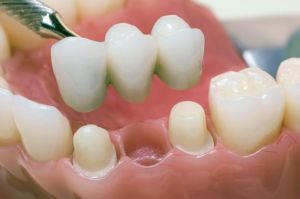 Dental problems, concomitant dental diseases, chronic diseases - there are many reasons to contact a specialist for the installation of dentures.
Dental problems, concomitant dental diseases, chronic diseases - there are many reasons to contact a specialist for the installation of dentures.
In order to have a beautiful smile, you should choose the right version of the prosthesis.
Among the options offered by dentists, bridge dentures are one of the most sought-after, since their design, consisting of two crowns between which the artificial teeth are attached, resembles the natural arrangement of teeth in the oral cavity.
Immediately the prosthesis looks like a bridge, hence the name.
Structure of construction:
- support;
- intermediate part.
The crown is placed on the support, which assumes the role of the structural holder, the intermediate part consists of the body of the prosthesis. There are removable and non-removable structures.
Contents
- Removable VS non-detachable
- Fixed construction
- Divided bridges. ..
- Pros and cons of
- construction Materials used
- Versions of prosthetic devices
- Not all fit. ..
- How is the dental bridge installed?
- Features of care
- Asked - answer
- Integrated opinion
- Price frames
Removable VS non-removable
Before contacting a specialist, it is necessary to choose whether the prosthesis will be removable or non-removable by the fixation method.
Fixed construction
Fixed prostheses are firmly attached and completely replace the removed teeth. They allow a person to wear their long period 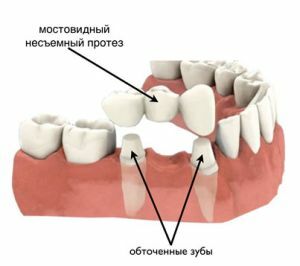 without removing. Most often, it is fixed bridges that are set for patients who do not have several teeth of the same row.
without removing. Most often, it is fixed bridges that are set for patients who do not have several teeth of the same row.
The non-detachable bridge is an integral construction consisting of several teeth. In the lateral parts are installed crowns, which are the supporting part of the entire prosthesis.
In order to install crowns, it is necessary to sharpen the extreme healthy teeth. According to the method of attachment, the bridge dentures are divided into:
- bridges on the lock fastenings;
- prostheses fastened on plates and tires( adhesive bridge);
- bridges on implants.
Divorced bridges. ..
Detachable prostheses are distinguished:
- Completely removable designs are installed when the shortage is 1 to 3 teeth per jaw, and it does not matter whether there are other dental defects. The main condition for setting removable bridges is that at least a few healthy teeth remain in the mouth, which will be the main support for the prosthesis. Completely removable it is customary to call those designs that replace all the teeth. They can be installed on both the upper and lower jaw.
- Partially removable bridges - plate, outwardly resembling a gum with teeth. Fixation of removable dentures is made with suction cups, locks or hooks, made of high-quality stainless metal or plastic.
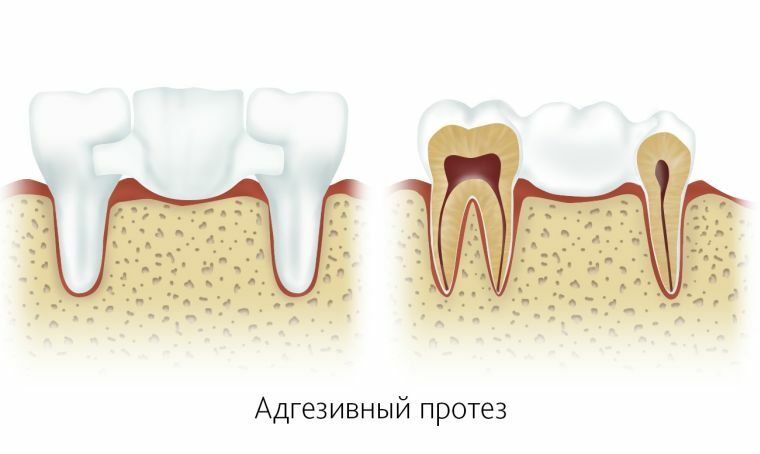
Advantages and disadvantages of
When choosing bridges, you need to know their advantages and disadvantages in order to avoid unexpected moments.
The nuances that have these designs will allow, when properly used, to forget that the teeth are part of the prosthesis.
Advantages of bridges:
- minimal damage to dental tissues;
- complete painless process of setting;
- absence of contact with the oral mucosa( no irritation);
- minimum restriction in food;
- ease of use;
- service life;
- affordable price.
In addition to the advantages of bridge bridges, both removable and non-removable type, there are disadvantages, which are also necessary to know about:
- prosthesis exerts additional stress on healthy teeth or jaws;
- may experience difficulties and discomfort in the oral cavity during shrinkage of the prosthesis;
- bone resorption sometimes occurs( in a place where there are no teeth);
- over time, the color of the prosthesis( artificial teeth) may change - darken;
- artificial teeth need special hygiene, because they are quickly erased;
- some of the materials from which the prosthesis is made can not provide the necessary margin of safety.
Used materials
Today you can choose bridges for teeth that are made of the following materials:
- plastic;
- ceramics;
- metal.
In addition, there are mixed materials - metal plastic and cermets. Due to the optimum parameters of reliability, quality, durability and aesthetics, the most demanded is a structure made of cermet.
More details about cermet bridges:
Types of prosthetic devices
Metal bridges are divided into:
- The cast is used more often because they are stronger, therefore, more durable in use and safer for the body.
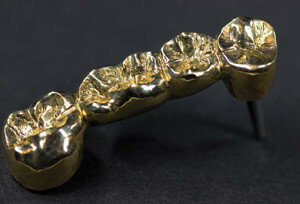
In the photo a solid cast bridge on the teeth
The stamped-brazed is less durable, therefore it is used less often.
- bridges from are ideally suited for chewing teeth, as well as the part that is visible in communication, as this material is aesthetically pleasing, looks natural, can be matched to the color of natural enamel, therefore, to distinguish healthy teeth fromprosthesis will be difficult.
- Plastic bridges are also popular, but still more often perform the task of temporary provision of comfortable communication and nutrition. Prostheses are installed on the front teeth, which are less loaded. In the absence of strong teeth, the bridge is fixed using implants.
Tooth bridges also come:
- with support on one side - cantilevered, they are installed if there are healthy teeth on one side;
- MERIDLAND prosthesis - fixed on a frame made of metal, attached to adjacent healthy teeth;
- cast prosthesis, are made of plastic or metal, durable, do not cause allergic reactions, inflammation;
- with support cores ( stamped) are easy to use, reliable;
- on the locks, if desired, can be removed for hygienic procedures;
- glued prosthesis, fixed on glass supports, does not require turning teeth.
- composite reinforced bridges .
Not for everyone. ..
The choice of this or that type of prosthesis depends on the number of healthy teeth, as well as on a number of other factors. It is important to take into account that there are contraindications for setting the bridge, among which:
- gnashing of teeth;

- in case of loss of 3 extreme teeth;
- incorrect bite;
- prone to abrasion;
- diseases of the oral cavity, including periodontal disease and periodontitis.
Given all this, the dentist makes a conclusion about whether it is possible to put a bridge and which prosthesis will be optimal to solve the existing problem.
How to install a dental bridge?
The installation of the bridge on the teeth takes an average of 2 days, since this process requires a multi-step approach:
- On the first day of the teeth, which will play the role of support for the bridge, the should be sawn up by the , a x-ray jaw can be required beforehand so that the doctor can determine the front of the work and their complexity. Grinding is also carried out at this stage.
- The connection element is then created, which connects the latches and the prosthesis for secure locking.
- The next stage is creating a special cast , which will be used by a specialist for the subsequent manufacture of an individual bridge. For this period, the dentist installs a temporary denture. This is also necessary for the body to get used to the changes.
- The next day, when the prosthesis is ready, the doctor gently removes the temporary bridge and inserts a permanent into its place, fixes and fixes it on the selected system.
- At the final stage, the is reconciled according to the color scheme. In addition, the doctor is interested in the sensations of the patient, because there may be discomfort or mild pain, but they quickly pass.
Features of care
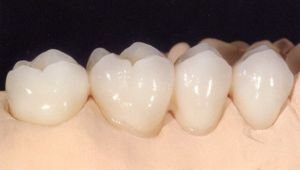 Many patients who have applied for dental prosthetics mistakenly believe that the issue of hygiene becomes secondary, since artificial teeth are installed in the mouth. However, this is not the case - the teeth and oral cavity as a whole still need regular cleaning. Procedures that need to be produced are not complex and require only a few minutes of personal time.
Many patients who have applied for dental prosthetics mistakenly believe that the issue of hygiene becomes secondary, since artificial teeth are installed in the mouth. However, this is not the case - the teeth and oral cavity as a whole still need regular cleaning. Procedures that need to be produced are not complex and require only a few minutes of personal time.
Prostheses are cleaned with a regular toothpaste and toothbrush, dental floss can also be used to provide additional hygienic treatment of hard-to-reach places.
In addition, special rinse liquids should be used. In the event that the prosthesis is removable, it is recommended to rinse it once a few days with additional usual running water.
Asked - answer
The most popular questions about bridge prosthetics and the answers to them:
- The service life of prosthesis? Bridge life from 5 years
- Is it possible to remove the bridge after installation? It is possible, but only after consultation with a specialist and if for that there is evidence.
- What should I look for when the life of the prosthesis exceeds 5 years ?It is necessary to pay attention to the mobility of the prosthesis, if it is easily removed, staggers, it is necessary to consult a specialist. Also, gums deserve attention - if there is redness or bleeding - a trip to the doctor is mandatory.
Comprehensive opinion of
Some practical experience of doctors and opinions of their patients.
I suffered for a long time with my teeth, but I did not try them, fillings, folk remedies, my teeth quickly collapsed, but the bridge prothesis helped to return a beautiful smile, and with it the opportunity to eat my favorite dishes, thanks to dentists.
Karim, 32
It's been 6 years since I forgot that at one time I did not have the most charming smile. Easy care of the prosthesis does not take much time, and I'm talking now without covering my mouth with my hand.
Vasilisa, 55
As a dentist I will say: bridges are a great way to regain oral health, because modern types of them allow avoiding turning, which is important in the treatment of teeth.
Orthodontist, 23 years of experience
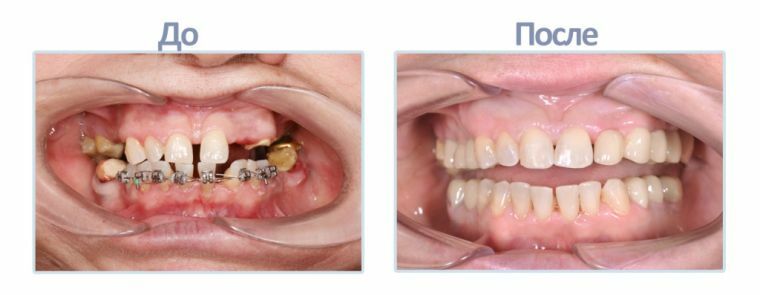
Price framework
Prices for bridges are available for most people wishing to install similar structures. How much will it cost to put the bridge on the teeth depends on the materials used and the number of prosthetic teeth: 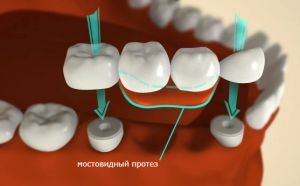
- design with an individual facet - from 2 thousand rubles
- cermet prosthesis - from 3.5 thousand rubles;
- ceramic prosthesis for the front teeth - from 10 thousand rubles;
- plastic bridge - from 1 thousand rubles;
- prosthesis with support on the implant - from 10 thousand rubles.
Thus, the bridge, regardless of the type and type of attachment, remains one of the most reliable and durable structures, allowing to return the lost beauty of a smile.
Proper maintenance of the prosthesis, timely cleaning, will not only preserve the quality of materials, but also extend the life of bridges.
